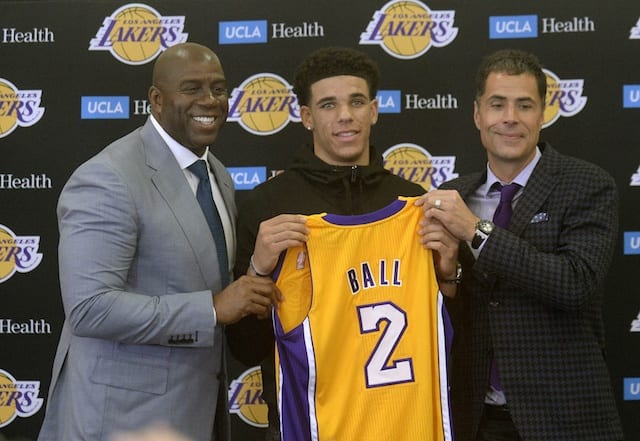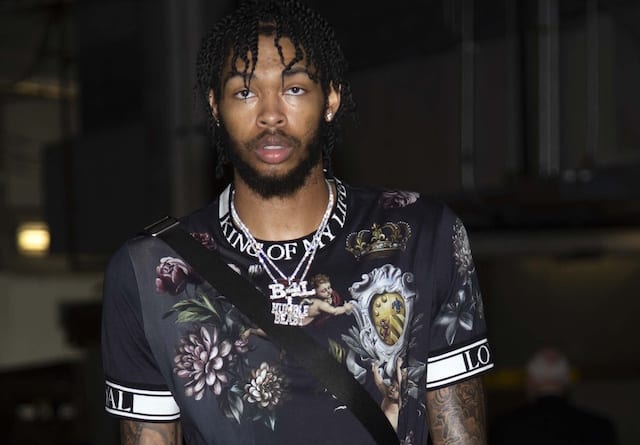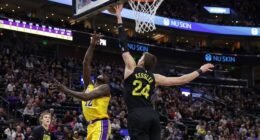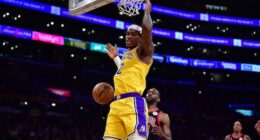
Now, I’m not a baseball fan in the slightest, but the depiction of the culture shift in the management of Major League Baseball teams was enlightening. The plot itself disclosed an emerging phenomenon in modern sports; a discourse that is visible in every forum board argument and fantasy sports league around the country. In fact, the more recent argument over whether Derek Fisher should return to Lakerland or not is indicative of these two dichotomous paradigms: the use of efficiency statistics vs. the solidified general wisdom of collective perspective.
“It’s hard not to be romantic about baseball,” says GM Billy Beane, in the film. It’s easy to understand the sentimental reasoning: baseball is America’s game. The same logic applies in basketball, although with a different flavor. Basketball, for the fans at least, is a game of heroes. And for the Lakers, Derek Fisher lines the hallways with snapshots of heroic moments. Moments of legend.
—- Kick off the season with your own Lakers Nation t-shirt! —-
While my purpose here isn’t to get in an argument over whether or not Fisher deserves to return to the team, it has indeed been interesting to see that the lines drawn for or against his return parallel the paradigms that I’ve already mentioned: the statistics that point out his efficiency vs. the collective knowledge that Fisher is clutch, dependable, and a valuable asset in terms of leadership.
General managers, from what I can tell, have hard jobs.
ESPN statistics guru Larry Coon recently published an incredibly insightful article on overpaid and underpaid players in the NBA, using a regression diagram to demonstrate what most players should earn based on their respective NBA ranks. While the statistics are by nature subjective (NBA Rank is an assessment that is voted upon by media members, and thus inherently slanted), the graph was very revealing. It seems that a great portion of NBA players are being overpaid, and the best ones are often underpaid.
The questions that came to me were these: How do general managers decide how much to pay a player? What about the Lakers as a team? Could Mitch Kupchak be considered one of the “smart” GMs? As a city with annual championship aspirations, are the Lakers getting the most bang for their buck? How do we compare with other notable “smart” franchises, especially in the Western Conference?
For the Lakers, making wise decisions financially is crucial. Packing a team with superstars can work, but it has its consequences, especially after the implementation of the new CBA. It is important to note the trends that occur throughout the league when making any business decision, whether they be for “heroic” players or not.
What are We Paying For?
These are the questions I sought, and am still seeking, to answer when I started this article. The basic premise can be found in Mr. Coon’s article (unfortunately, it’s an Insider article on ESPN, so you’ll have to subscribe to read it). I’ll leave it for him to explain the basics:
“By computing a player’s actual salary against his expected salary based on his NBA Rank score, you can determine whether he is underpaid or overpaid for what he delivers on the court. Fortunately, most players’ salaries are commensurate with their performance — in other words their points on the graph are fairly close to the trend line.
But there are a few outliers — players whose salaries are nowhere near what you would expect them to be. The farther a dot is above the trend line, the more overpaid the player; and conversely, the farther below the trend line, the more underpaid (but a better bargain for the team).”
If you look at the graph, most players fall in line with the “trend” line, or regression line. The line delineates what a player would be expected to make based on their on-court performance. The better you are viewed as a player, the higher your NBA rank, and concurrently the increase in salary. The graph shown is Mr. Coon’s graph, with some caveats as to the details.

The data point farthest right is, of course, LeBron James. He scored a 9.99 on the NBA Rank scale, and as such, is one of the most underpaid players in the league. At least we know he didn’t move to Miami solely for the money.
In essence, the further a player is under the regression line, the more underpaid he is, and the further above, the more overpaid he is. It is a useful tool in determining a player’s value at a glance without getting too far into a discussion.
For starters, Coon used the player’s current NBA Rank with last year’s salary. His explanation for this was that NBA Rank is typically based off of the player’s performance during the 2010-2011 season, and so last year’s salary should be used.
Coon also used the NBA Rank score this year instead of their NBA Rank number. This allows the data to be more clumped, as opposed to an extended line that reaches over a large range. This is more reflective of real life groupings.
Finally, Coon made note of the “standard Kobe Bryant disclaimer,” stating that although a player’s data point may suggest that he is indeed overpaid, the revenue said player (Kobe Bryant) brings in to the organization from tickets, jersey sales, and television ratings would alter his status as “overpaid.” While the graph is based on purely on-court performance and Kobe could be seen as overpaid, the money he brings in from television and sales suggests that in actuality, he is underpaid. This applies to some other superstar players as well.

What was frustrating to me was that the data points on the graph (for the most part; there were some obvious outliers) did not demonstrate which players on which teams ranked where. While the article demonstrated the top ten most underpaid and overpaid players, it didn’t give explicit details for each team. I’ve attempted to accomplish such in my graphs below.
Some notes as to the differences between my diagrams and those aforementioned.
First, I used this year’s salaries instead of last year’s. While last year’s performance was the foundation for those player’s NBA Rank, that NBA Rank is the current evaluation of these players to start out the year. For example, we cannot speculate as to what Kobe’s NBA Rank will be at the end of this year. But we do know what he should be ranked at now, and the Lakers organization is committed to paying him a certain salary for this year based on what his score is right now, not what it is in the future. Using this year’s salary will provide a better picture what we should expect from that player this year. This change should result in slightly different data points from that of Coon’s graph.
In the graphs below, I’ve highlighted the players from four different teams: the Los Angeles Lakers, the San Antonio Spurs, the Oklahoma City Thunder, and the Denver Nuggets. I’ve selected these four teams because, in my opinion, these are the four main contenders for the Western Conference this year. Secondly, these four teams represent teams that, for the most part, are viewed as “smart franchises” throughout the league. Whether it be bringing in marquee free agents or maintaining consistent excellence in small markets, these four teams represent the cream of the crop.
Next Page: Numbers Game: Breaking Down the League’s Best Teams






